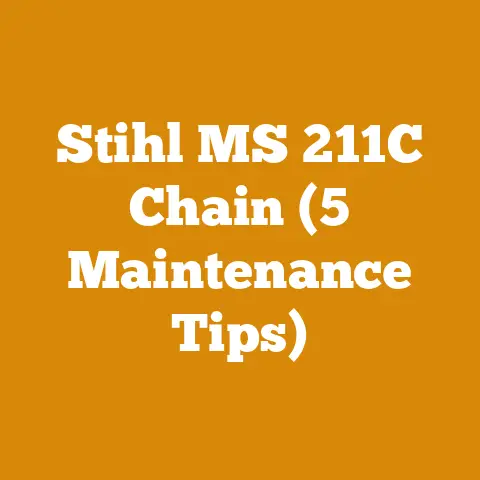Can You Use a Stihl Bar on a Husqvarna Chainsaw (3 Answers)
Have you ever found yourself deep in the woods, staring at your tools and wondering, “Can I use a Stihl bar on my Husqvarna chainsaw?” It’s a thought that has crossed many minds, especially for those of us who juggle tools from different brands.
Let me take you through what I’ve learned over years of cutting, sawing, and sometimes improvising.
My Journey with Chainsaws: A Personal Tale
It’s funny how life leads you down unexpected paths.
My affair with chainsaws began one crisp autumn day when I was faced with a massive tree blocking my driveway.
My trusty Husqvarna had served me well over the years, but on that particular day, it decided to act up.
As I stared at the stubborn tree and my malfunctioning saw, I remembered a Stihl bar sitting in my shed.
Could it be the solution?
That day marked the beginning of my exploration into the compatibility between different chainsaw brands.
It was an adventure filled with trial, error, and a fair share of learning.
The Big Question: Can You Use a Stihl Bar on a Husqvarna Chainsaw?
The short answer is sometimes. The long answer? Well, let’s explore it together.
1. Compatibility Check: The Basics
Every chainsaw is like a puzzle piece with its own unique fit.
Stihl and Husqvarna have designed their bars and mounts in specific ways, often differing in oil hole placements and tensioner hole positions.
This means that not every bar will seamlessly fit onto another brand’s saw.
Tip: Before attempting any swap, lay both bars side by side.
Compare the placements of holes and mounts to ensure they match.
2. Chain Size and Pitch: The Technical Details
If you’re like me, technical details might not be your favorite part of the job, but they’re crucial here.
Chains come in various sizes and pitches, which must align perfectly with both the bar and the sprocket.
Example: Imagine your Husqvarna uses a .325 pitch chain while your Stihl bar supports a different size.
This mismatch could spell trouble, leading to poor performance or even damage.
3. Drive Link Count: The Overlooked Factor
Drive link count is something I’ve seen many overlook, yet it’s vital for compatibility.
Each chain has a specific number of drive links that must correspond with the bar length and sprocket configuration.
Warning: Using a chain with an incorrect drive link count can lead to excessive wear or even catastrophic failure.
Steps to Swap Bars Safely
Now, if you’re considering swapping bars, let me guide you through the process:
Materials Needed
- Compatible Stihl bar
- Matching chain (correct pitch and drive link count)
- Chainsaw tool kit
- Safety gear: gloves, eye protection
Prerequisite Knowledge
You should have a solid understanding of chainsaw mechanics and maintenance practices.
Step-by-Step Process
- Inspect the Chainsaw:
Before you start, give your Husqvarna a thorough inspection to ensure it’s in good working order. - Safety First:
Disconnect the spark plug to prevent accidental starts.
Trust me; this step is non-negotiable! - Remove Existing Bar:
Use your chainsaw tool kit to remove the clutch cover.
Carefully take off the current bar and set it aside. - Check Compatibility:
Place the Stihl bar alongside your Husqvarna’s mount.
Ensure all holes line up perfectly. - Install New Bar:
Fit the Stihl bar onto the mount securely.
Double-check that everything is aligned properly. - Fit the Chain:
Make sure the chain fits snugly onto the bar and sprocket.
Adjust tension as needed. - Reassemble Chainsaw:
Replace the clutch cover and tighten all bolts securely. - Test Run:
Perform a test cut on a small piece of wood to ensure everything operates smoothly.
Listen for unusual noises or vibrations.
Caution: Always wear protective gear when testing or using a chainsaw.
Safety should never be compromised.
Safety Precautions: A Must-Follow Guide
When working with chainsaws, safety is paramount.
Here are some critical precautions to keep in mind:
- Double-check all fittings before starting.
- Ensure your chain brake is functional at all times.
- Regularly maintain your saw for optimal performance.
- Always use proper safety gear: helmets, gloves, ear protection, and sturdy boots.
Real-Life Lessons Learned
I recall an experience where I ignored a minor mismatch in drive link count, thinking it wouldn’t matter much.
Halfway through a job, my chain slipped off mid-cut—a scary moment that could have been avoided with proper attention to detail.
Common Questions and Troubleshooting
What if the Bar Doesn’t Fit?
If you’ve meticulously followed all steps and the bar still doesn’t fit, it’s best to use bars specifically designed for your chainsaw model.
Chain Keeps Slipping Off—Why?
This could be due to incorrect tensioning or mismatched drive links.
Re-examine these factors before proceeding.
Saw Feels Underpowered—What’s Wrong?
An underpowered saw might indicate an incorrect chain pitch or drive link count.
Double-check all specifications for accuracy.
Unexpected Noises or Vibrations?
Listen carefully to your saw during operation.
Unusual noises often mean something’s off—perhaps a loose bolt or an ill-fitting component.
Best Practices for Chainsaw Maintenance
- Regularly clean your bar and chain to prevent buildup.
- Inspect all parts for wear and replace them as needed.
- Lubricate moving parts frequently to ensure smooth operation.
- Store your chainsaw in a dry place to avoid rusting.
The Importance of Regular Inspections
Routine inspections can save you from unexpected failures at crucial moments.
Set aside time each month to go over every part of your saw carefully.
Final Thoughts: Embrace Learning
Swapping bars between brands like Stihl and Husqvarna can be done if you’re cautious and detail-oriented.
Remember, safety always comes first.
Ensure everything is compatible before attempting any swaps.
A Word of Encouragement
Don’t be afraid to experiment and learn through hands-on experience.
Mistakes are part of the learning curve—just make sure they’re safe ones!
FAQs
Can I use any bar on any chainsaw?
Not quite.
Always ensure compatibility in terms of mount type, chain size, pitch, and drive link count.
Do I need special tools for bar swapping?
A standard chainsaw tool kit should suffice for most tasks.
Is there a risk of damage?
Yes, if components aren’t compatible or properly fitted, damage can occur.
Always double-check everything.
Why does my chain seem too tight or too loose?
This is often due to incorrect tensioning or an incompatible bar/chain setup.
By following these insights and steps, you’ll be well on your way to making an informed decision about using a Stihl bar on a Husqvarna chainsaw.
As always, approach each job with care and curiosity—you never know what you might discover along the way!






